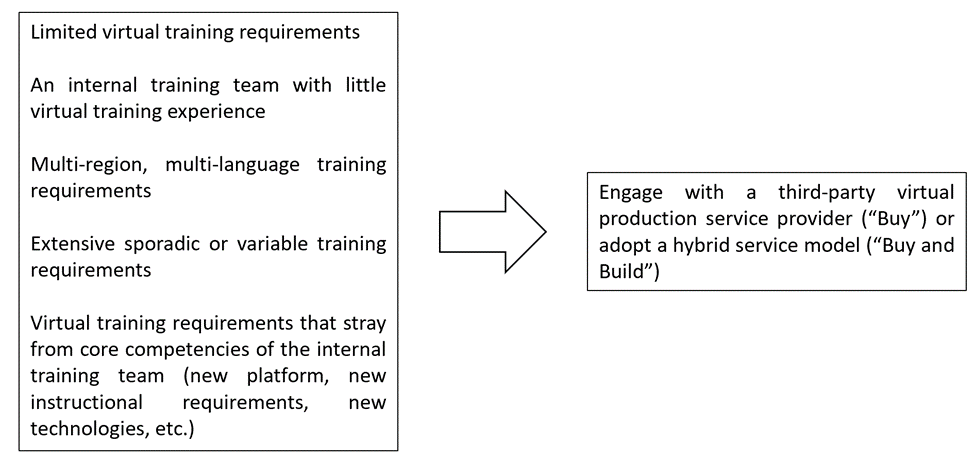7 Considerations When Selecting a Virtual Training Production Partner
The Decision is Made to Outsource – Now What? Virtual classroom producers allow your training team to access the specialized knowledge needed for...
7 min read
.jpg) Dr. Charles (Chip) Dye, Ph.D.
:
Jan 23, 2023 11:00:00 AM
Dr. Charles (Chip) Dye, Ph.D.
:
Jan 23, 2023 11:00:00 AM

Producer. Host. Moderator. Several terms have been used to describe the more-than-technical-support role in a virtual classroom instructional session. For more than 20 years, InSync Training has provided this service for a variety of large-, mid- and modest-sized clients. If trained properly, producers transform virtual learning programs into trouble-free, fast moving, interactive events that keep learners involved and support the facilitator to stay on track, consistent, and effective.
Most professional training has incorporated at least some virtual live instruction in the last three years – and a lot of lessons (good and bad) were learned by facilitators learning the virtual ropes. In our experience, the virtual classroom producer (also known as a virtual classroom ‘host’) is a key element in ensuring instructional success.
The producer enhances the instructional experience to the next level of professional online delivery so the details don’t get in the way of the content message. With a producer’s support, facilitators or subject matter experts can concentrate on the quality of the conversation with learners and the content. Unlike facilitation in the virtual classroom, production rarely, if ever, requires subject matter expertise in the materials being taught, but rather focuses entirely on the virtual learning environment and the learner experience.
Since 2000, our production team has worked extensively with new clients who invested in a BUY scenario for their production capability as they onboarded new hires to establish some best practices and operational guidelines to optimize the learner experience. During the pandemic (and since) service requests have more than quadrupled. Similarly, teams have chosen to BUILD their team by providing certifications to aid in-house capability, which brings us to the debate of “Buy or Build” for virtual classroom production capability.
scenario for their production capability as they onboarded new hires to establish some best practices and operational guidelines to optimize the learner experience. During the pandemic (and since) service requests have more than quadrupled. Similarly, teams have chosen to BUILD their team by providing certifications to aid in-house capability, which brings us to the debate of “Buy or Build” for virtual classroom production capability.
The decision to BUY or BUILD virtual classroom capability ultimately is interwoven with the unique circumstances of each organization, but the factors determining which way to go are fairly consistent. What is the SCOPE of the project? And what RESOURCES are available?
It's not just the normal day-to-day operations you need to keep in mind. You need to plan for out-of-the ordinary programs. For example:
The arguments to BUILD internal production and host capability largely boil down to three items:
Each of these are valid concerns, so let’s take a look at them one at a time.
Several of InSync’s clients (particularly the mid- and smaller-sized clients (< 1,000 employees)) often come to us after developing some in-house capability to support their virtual training needs. Upon entering the virtual training domain, these organizations struggled with a variety of variable and intricate requirements of global delivery, coordination across time zones, and regional language support, to name a few. In addition, they believed that by keeping the work in-house, it would keep costs low. As it turned out (for them, at least) the costs savings by using in-house resources for virtual production paled in comparison to the actual costs of supporting virtual training. If the decision is to bring production in-house, there are a few resources (particularly cost) considerations in deciding to rely solely on internal capability:
An individual (let’s call him Fred) is assigned a supplemental role as a producer in addition to their principal role as an instructional administrator. Let’s assume that schedule demand for virtual training is moderate for the organization – roughly eight hours (four two-hour sessions) of delivery a week. To support this eight hours of instruction well, Fred will have to spend at least 11-12 hours logged into the sessions (opening it early, closing at the end of the session, plus post-delivery admin), plus a few hours of preparation, an hour touching base with the Facilitator to address any issues, plus an amortized 30 min.- 1 hour of set-up/review of the virtual classroom (polls, links, etc.). All of a sudden, Fred is now working 40% of his 40-hour work week supporting eight hours of training. In addition, well run virtual training programs coordinate the overlap of the Facilitator and Producer to ensure both are available at the same times for both preparation and delivery of the session, so we need to include some fraction of that labor cost.
The costing example ignores the negative effects on efficiency from intermittent task scheduling, wherein our stalwart Producer Fred will have to adapt his work schedule to the needs of the training. Looking at this the other way, the most training Fred could support in a week is somewhere around 28 hours of delivery a week, if he’s a dedicated full-time virtual producer, with seamless co-scheduling of sessions, etc. Moreover, if you consider the need of a back-up in the event Fred gets sick or loses internet (we’re assuming Fred is WFH) or stuck in traffic (Fred is WFO), the costs rise further, and you may be stuck if you have multiple sessions running concurrently and have no redundancy.
At the end of the day, the costs may still work in favor of internal capability, but the argument is generally far weaker than most people think because the costs associated with a burdened labor hour of an internal employee generally are multiples of their actual hourly rate. In most situations, our experience has shown that the costs for an internal team (dedicated or partially assigned) is actually higher than the rates typically charged by a reputable service provider and the overall service level support is inferior compared to the service provider approach.
Supply chain considerations in some sectors of the economy certainly argue for consolidation, rather than distribution, but virtual training likely isn’t one of them for your organization. In developing a virtual training capability, InSync has observed a range of outcomes and in most cases is retained by the organization (even in successful instances) because there is simply a need for surge capacity (more on this at the end of this article). If the concern revolves around dependence on a third party in execution of a business function, the key is to select the appropriate provider, rather than to build only internal capability. As an example, a large trans-national Forbes 100 technology company with presence in multiple regions contacted InSync to support 182 live one-hour sessions in a three-day period in support of an organization-wide alignment and business structuring. These sessions were to be delivered in 8 languages, across 20 time zones (west coast US to east coast Australia and Japan). “OK” you’re thinking, “that’s a bit of a challenge, but you can plan for it” – and you’re right, but the real challenge lays in the scheduling – the services were required within eight calendar days of identifying the requirement. The service provider they usually worked with could not support foreign languages and could not support all the sessions. The reality is that a service provider with sufficient depth of bench can cover just about any operational need for virtual training support you can reasonably impose and can actually free up your internal resources to support other critical parts of your training infrastructure and objectives.
Certainly, the protection of business sensitive information should be top-of-mind for deciding whether to bring a third party into a virtual session. The materials may include proprietary processes, pricing, or something as mundane as an organizational change. Like any other situation, however, there are simple and effective engineering controls that can be implemented to ensure the materials or information stays with the intended audience, and they are:
With these in place, the risks presented by using a third-party virtual producer are minimized, and likely introduce as little risk of unwanted dissemination as the internal team itself.
When you consider the facts in the scenario above, the decision to buy becomes a little easier to articulate. The figure below provides a rough set of guidelines to use in deciding to adopt a third-party services provider model.

There are certainly instances when developing a robust internal virtual production capability is appropriate. One such case is if your organization is or includes a large training team with a strong virtual training demand such that full-time or near full-time allocation of the producer role can be made to multiple people. In this case, language and region-support can be accommodated with a distributed team working in disparate time zones. Even for those organizations, however, there is still a strong argument to engage with a service provider using a hybrid approach to address some virtual training with in-house resources and outsource others – because everyone has a plan until some training requirement hits you in the mouth (apologies to Mike Tyson and professional boxers everywhere. ).
InSync works with several clients that fit a profile that indicates an internal virtual capacity is necessary. In those cases, InSync was initially engaged as a training skill development provider for client teams and as an interim solution until the client developed a critical mass of talent within the team. Once we had finished the certification of the team, we expected them to “go out in the world” and do great (virtual training) things. Interestingly, most of those clients continue to engage InSync for a service contract to provide the production and facilitation services on an as-needed basis as a surge capacity when training demand exceeded the internal capability to support. Ultimately, that is the strength of the “Buy” and the hybrid service approach – it is scalable and responsive.
Moving to an in-house virtual training production model can have a number of benefits and can reduce cost, but it is extremely important to consider all the above factors in making the BUY or BUILD decision. In InSync’s experience, a third party or hybrid/internal external provider model can have the most positive effect that allows the internal training team to focus on key, frequent repetitive virtual training deliveries while using third party providers for surge support and unique training requirements.
[Take 5 Minutes to Answer This Survey& Get Your Roadmap to Virtual Classroom Production Excellence]

The Decision is Made to Outsource – Now What? Virtual classroom producers allow your training team to access the specialized knowledge needed for...
 Read More
Read More